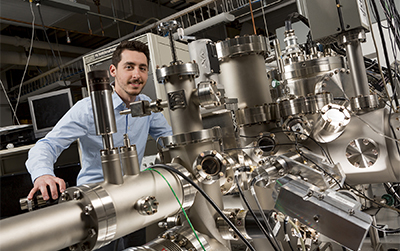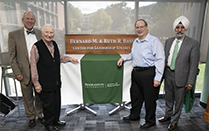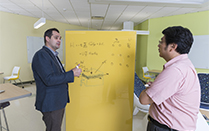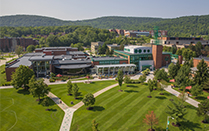
Physicist earns postdoctoral fellowship
There’s an observation in computer science called Moore’s Law that predicts that the number of transistors packed into an integrated circuit will double approximately every two years. This prediction has held true since the 1970s, and it’s why your iPhone has more computing power than the computers that sent astronauts to the moon. But there are physical limits to the silicon wafers computer chips rely on, and the industry is rapidly reaching the point where it’s physically impossible to cram more transistors — those little on-off switches that make up the binary machine language of computers —together.
“All technology now, say, your cellphones, laptops and most any kind of handheld and especially nano-based technology, are all based on silicon,” says Nick Quackenbush, a PhD candidate in physics at Binghamton. “We’re close to the limit with silicon. There are fundamental physical limits to how small you can make it and have it still actually work.”
Quackenbush and other researchers are looking to push beyond the limitations of silicon by using metal oxides — chemical compounds that contain at least one oxygen atom and one other metal element. That will be the focus of his research when he starts a prestigious National Institute of Standards and Technology postdoctoral research program in December at Brookhaven National Laboratory.
Metal oxides include some of the best — and worst — conductors of electricity. Their properties can change abruptly with temperature, light and electricity. And when two insulating metal oxides touch, a conductive channel can form under certain conditions that can be controlled like a switch.
“Understanding how and why this happens could enable us to build oxide-based electronics that are better and even more compact than our current silicon-based nano technologies,” Quackenbush says.
Louis Piper, an assistant professor of physics at Binghamton and Quackenbush’s advisor, said the two have also worked on separate but related research with applications for “smart windows.” Such windows, Piper says, could block infrared light and allow natural light to enter a room without the downside of feeling the heat or glare of the sun. “So at the moment I’m in my office, the sun is beaming down on my glass, I want to put the blinds down and turn the lights on, which is not really energy-efficient,” Piper says. “It would be better if I could just block the infrared and take advantage of the ambient lighting.”
Piper said another possibility for the metal oxides Quackenbush studied at Binghamton would be to use them as “memristors” — tiny devices that can store information permanently, switch on and off in billionths of a second and use very little power.
Quackenbush will spend his three-year fellowship at Brookhaven working on the National Synchrotron Light Source II, which will be the world’s most advanced synchrotron when it’s fully operational. A synchrotron emits high-energy X-rays that researchers use to study materials.
Quackenbush beat out a number of proposals from larger physics programs such as Harvard’s, making his postdoctoral fellowship a coup for Binghamton as well.







